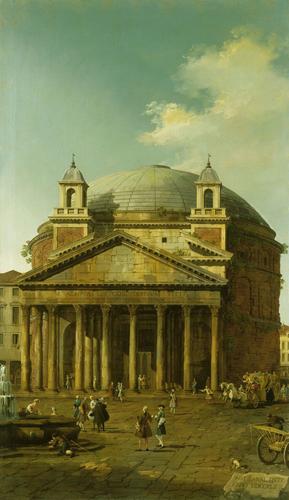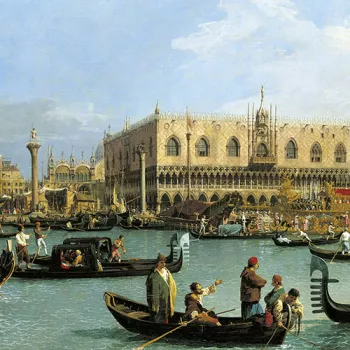The Pantheon Signed and dated 1742
Oil on canvas | 183.5 x 105.7 cm (support, canvas/panel/stretcher external) | RCIN 400524

Canaletto (Venice 1697-Venice 1768)
The Pantheon Signed and dated 1742


-
This painting is one of a unique group of five large upright views of Rome, depicting the major sights of the ancient city (RCIN 401002, RCIN 400700, RCIN 400713, RCIN 400524, RCIN 400714). Unusually for Canaletto, all the works are signed and dated prominently in the foreground. It is thought that the paintings formed a special commission for Canaletto's great friend and patron Joseph Smith, British Consul in Venice, who sold his outstanding group of paintings, prints and drawings to George III. Their tall narrow format suggests that the paintings were originally designed for a specific location, probably decorating a room within Smith's palace on the Grand Canal, however the cycle does not fall into an obvious arrangement. Acquired by George III in 1762, the paintings were hung in English frames in the Entrance Hall of Buckingham House, alongside the Venetian views.=
This painting depicts The Pantheon, the best preserved monument of ancient Rome and the greatest symbol of the Empire. The direction of light suggests the early morning: the view is from a shaded position to a fully lit stage. A shadow falls exactly across the portico but illuminates the inner columns in a complex interplay of light and shade. Thus Canaletto conveys the glory of an imperial age now long past by the Pantheon's massive grandeur, emerging from deep shadows and showing the ravages of time. The vertical format, the low viewpoint and the admiring group of visitors on the Grand Tour emphasise this sense of a monumental past, the brightly clad figures contrasting with the browns of the stonework. The first temple on the site of the Pantheon was built in 27 BC by Agrippa, but the existing building with its dedicatory inscription was erected by Hadrian in the second century AD. It was one of the few monuments of pagan antiquity to be converted into a church in the seventeenth century. Its thirteenth-century campanile was replaced by bell towers in the seventeenth century. The fountain is shown without the obelisk bearing the arms of Pope Clement XI installed in 1711.
Unlike the other four Roman monuments in this series, the Pantheon had all the noise and dirt of a poorer, residential part of the city. Visitors commented on the lack of cleanliness and the bustle, contrasting this with the solitude to be found in the Colosseum. A luxurious contemporary coach in rococo style with rearing horses breaks in from the right. An antiquarian guide walks beside the coach while an attendant in livery races before it. The prosaic cart in the right foreground contrasts with the ebullience of the coach and horses arriving behind; the influence of Bellotto and of Gian Paolo Panini's contemporary views of Rome has been traced in such details.
Signed and dated ANT.CANAL FECIT / ANNO MDCCXLII
Adapted from Canaletto & the Art of Venice, London, 2017.Provenance
Acquired in 1762 by George III from Joseph Smith, British Consul in Venice (Italian List no 57); recorded in the Hall at Buckingham Palace in 1790
-
Medium and techniques
Oil on canvas
Measurements
183.5 x 105.7 cm (support, canvas/panel/stretcher external)
212.0 x 131.1 x 14.8 cm (frame, external)
Category
Object type(s)
Other number(s)
Alternative title(s)
Rome: The Pantheon








